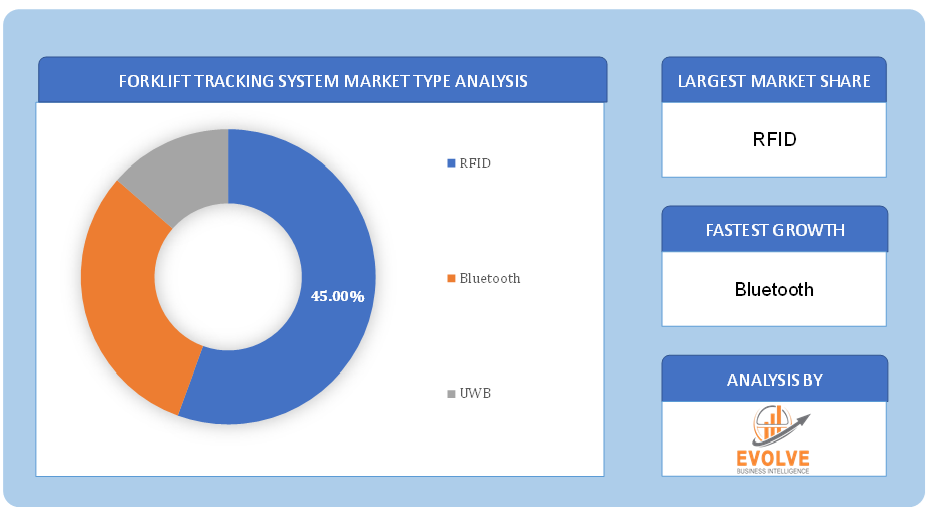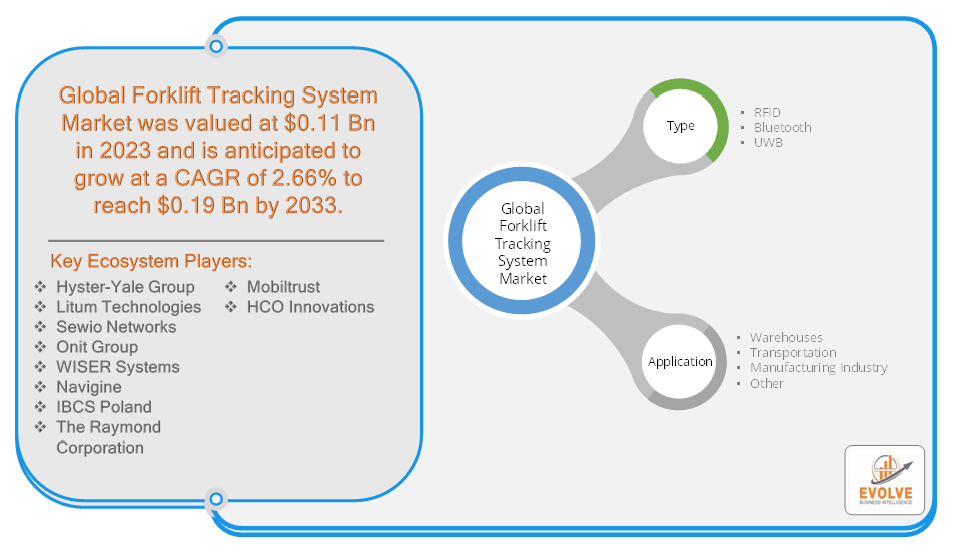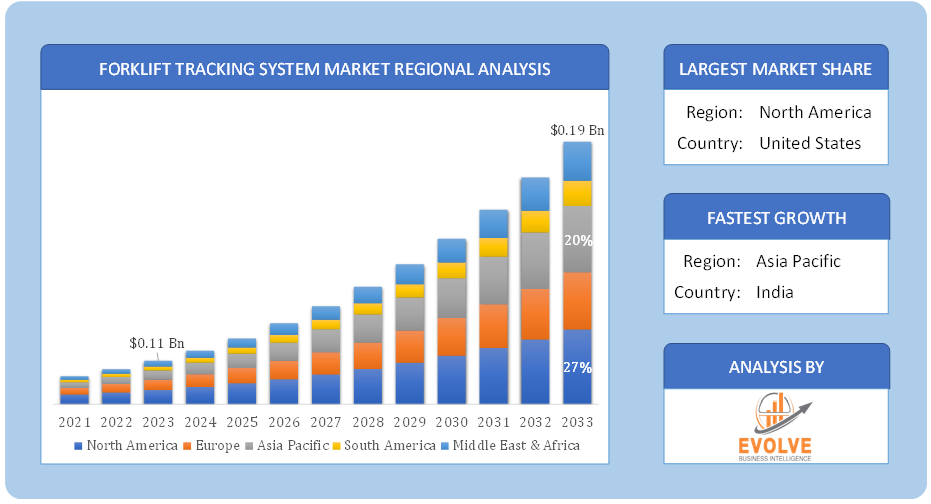Forklift Tracking System Market Analysis and Global Forecast 2023-2033
$ 1,390.00 – $ 5,520.00Price range: $ 1,390.00 through $ 5,520.00
Forklift Tracking System Market Research Report: Information By Type (RFID, Bluetooth, UWB), By Application (Warehouses, Transportation, Manufacturing Industry, Other), and by Region — Forecast till 2033
[vc_row][vc_column width=”2/3″][vc_column_text woodmart_inline=”no” text_larger=”no”]
Forklift Tracking System Market Overview
The Forklift Tracking System Market Size is expected to reach USD 0.19 Billion by 2033. The Forklift Tracking System industry size accounted for USD 0.11 Billion in 2023 and is expected to expand at a compound annual growth rate (CAGR) of 2.66% from 2023 to 2033. A Forklift Tracking System refers to a comprehensive technological solution designed to monitor and manage the location, usage, and performance of forklifts within industrial environments. It typically incorporates a combination of hardware and software components to facilitate real-time tracking and data collection. By utilizing technologies such as GPS or RFID tags, sensors, and data collection devices, the system enables businesses to gain insights into forklift utilization, optimize fleet allocation, enhance operational efficiency, ensure compliance with safety regulations, and improve overall productivity in material handling operations. The central tracking system, along with its user interface, processes and stores the collected data, providing managers and operators with real-time visibility and actionable information for effective decision-making.
Global Forklift Tracking System Market Synopsis
The Forklift Tracking System market experienced a significant and transformative impact due to the COVID-19 pandemic. As businesses grappled with the challenges of supply chain management and employee safety, the need for effective solutions became paramount. Forklift tracking systems emerged as a critical tool to address these challenges by enabling efficient monitoring and management of forklift operations. These systems provided real-time visibility into key aspects such as forklift locations, usage, and performance, enabling businesses to optimize fleet allocation, reduce unnecessary movement, and ensure adherence to safety guidelines. Moreover, they played a vital role in facilitating contact tracing efforts in the event of suspected COVID-19 cases. Consequently, the demand for forklift tracking systems witnessed a surge as organizations recognized their potential to enhance operational efficiency, safety, and resilience in the face of unprecedented disruptions caused by the pandemic.
Forklift Tracking System Market Dynamics
The major factors that have impacted the growth of the Forklift Tracking System are as follows:
Drivers:
Increasing Emphasis on Workplace Safety
There is a growing focus on workplace safety regulations and standards, which is driving the demand for forklift tracking systems. These systems provide real-time visibility into forklift operations, helping businesses ensure compliance with safety protocols, minimize accidents, and create a safer work environment.
Restraint:
- Initial Investment Costs
The implementation of a forklift tracking system requires an initial investment in hardware, software, and infrastructure. This upfront cost can be a deterrent for some businesses, especially smaller ones with limited budgets. The initial investment may hinder the adoption of forklift tracking systems, acting as a restraint in the market.
Opportunity:
Increasing Automation and Integration
The integration of forklift tracking systems with other automation technologies, such as warehouse management systems (WMS) and enterprise resource planning (ERP) systems, presents significant opportunities for the market. This integration allows for seamless data exchange, improved operational efficiency, and better decision-making processes.
Forklift Tracking System Segment Overview
By Type
 Based on Type, the market is segmented based on RFID, Bluetooth, and UWB. The RFID segment is expected to have a larger market share throughout the forecast period. This is primarily due to the numerous advantages offered by RFID technology in tracking and managing forklift operations. RFID enables automatic identification and tracking of forklifts through radio frequency signals, ensuring accurate and real-time monitoring of their locations, movements, and usage. The technology provides enhanced tracking accuracy, enabling businesses to optimize fleet allocation, improve operational efficiency, and ensure compliance with safety regulations.
Based on Type, the market is segmented based on RFID, Bluetooth, and UWB. The RFID segment is expected to have a larger market share throughout the forecast period. This is primarily due to the numerous advantages offered by RFID technology in tracking and managing forklift operations. RFID enables automatic identification and tracking of forklifts through radio frequency signals, ensuring accurate and real-time monitoring of their locations, movements, and usage. The technology provides enhanced tracking accuracy, enabling businesses to optimize fleet allocation, improve operational efficiency, and ensure compliance with safety regulations.
By Application
Based on Application, the market has been divided into Warehouses, Transportation, Manufacturing Industry, and Others. The Transportation segment is anticipated to dominate the market. This can be attributed to the increasing need for efficient transportation and logistics operations across various industries. Forklift tracking systems play a crucial role in managing and optimizing forklift operations in transportation, including warehouses, distribution centers, ports, and airports. These systems enable real-time tracking of forklifts, providing visibility into their locations, usage, and performance, which is essential for effective fleet management and resource allocation.
Global Forklift Tracking System Market Regional Analysis
Based on region, the global Forklift Tracking System market has been divided into North America, Europe, Asia-Pacific, the Middle East & Africa, and Latin America. North America is projected to dominate the use of the Forklift Tracking System market followed by the Asia-Pacific and Europe regions.
North America Market
North America has consistently held a dominant position in the Forklift Tracking System market. This can be attributed to several factors. Firstly, North America has a well-developed industrial sector with advanced logistics and supply chain operations. The region has a high adoption rate of technology and is often an early adopter of innovative solutions. Additionally, there is a strong emphasis on workplace safety regulations and compliance, which drives the demand for forklift tracking systems. The presence of key market players and technological advancements in the region further contribute to its dominance. Furthermore, North America has a robust infrastructure and a high level of awareness regarding the benefits of forklift tracking systems in improving operational efficiency, safety, and productivity. With these advantages, North America is expected to maintain its dominant position in the Forklift Tracking System market.
Asia-Pacific Market
The Asia-Pacific region has emerged as a rapidly growing market for the Forklift Tracking System industry. Several factors contribute to this growth. Firstly, the region is witnessing significant industrial growth, particularly in countries like China, India, and Southeast Asian nations. This growth is driving the demand for efficient supply chain management and logistics operations, where forklift tracking systems play a crucial role. Additionally, the increasing adoption of advanced technologies and the booming e-commerce sector in the Asia-Pacific region are driving the need for enhanced operational efficiency and real-time tracking of forklifts. Moreover, there is a growing focus on workplace safety and compliance with regulations, which further boosts the demand for forklift tracking systems. With these factors in play, the Asia-Pacific region is expected to experience substantial growth and become a prominent market for the Forklift Tracking System industry.
Competitive Landscape
The Global Forklift Tracking System market is highly competitive, with numerous players offering a wide range of software solutions. The competitive landscape is characterized by the presence of established companies, as well as emerging startups and niche players. To increase their market position and attract a wide consumer base, the businesses are employing various strategies, such as product launches, and strategic alliances.
Prominent Players:
- Hyster-Yale Group
- Litum Technologies
- Sewio Networks
- Onit Group
- WISER Systems
- Navigine
- IBCS Poland
- The Raymond Corporation
- Mobiltrust
- HCO Innovations
Key Development
In May 2023, Hyster Company introduced the Dynamic Stability System (DSS), a cutting-edge solution designed to enhance forklift safety by offering automated performance controls and alerts. The DSS aims to mitigate the risk of forward and sideways tip-overs, ensuring safer operating practices. This innovative system comes as a standard feature on all H40-70A models included in the newly launched Hyster A Series.
Scope of the Report
Global Forklift Tracking System Market, by Type
- RFID
- Bluetooth
- UWB
Global Forklift Tracking System Market, by Application
- Warehouses
- Transportation
- Manufacturing Industry
- Other
Global Forklift Tracking System Market, by Region
- North America
- US
- Canada
- Mexico
- Europe
- UK
- Germany
- France
- Italy
- Spain
- Benelux
- Nordic
- Rest of Europe
- Asia Pacific
- China
- Japan
- South Korea
- Indonesia
- Austalia
- Malaysia
- India
- Rest of Asia Pacific
- South America
- Brazil
- Argentina
- Rest of South America
- Middle East & Africa
- Saudi Arabia
- UAE
- Egypt
- South Africa
- Rest of Middle East & Africa
| Parameters | Indicators |
|---|---|
| Market Size | 2033: $0.19 Billion |
| CAGR | 2.66% CAGR (2023-2033) |
| Base year | 2022 |
| Forecast Period | 2023-2033 |
| Historical Data | 2021 |
| Report Coverage | Revenue Forecast, Competitive Landscape, Growth Factors, and Trends |
| Key Segmentations | Type, Application |
| Geographies Covered | North America, Europe, Asia-Pacific, Latin America, Middle East, Africa |
| Key Vendors | Hyster-Yale Group, Litum Technologies, Sewio Networks, Onit Group, WISER Systems, Navigine, IBCS Poland, The Raymond Corporation, Mobiltrust, HCO Innovations |
| Key Market Opportunities | • Integration with Advanced Technologies |
| Key Market Drivers | • Increasing Emphasis on Workplace Safety |
REPORT CONTENT BRIEF:
- High-level analysis of the current and future Forklift Tracking System market trends and opportunities
- Detailed analysis of current market drivers, restraining factors, and opportunities in the future
- Forklift Tracking System market historical market size for the year 2021, and forecast from 2023 to 2033
- Forklift Tracking System market share analysis at each product level
- Competitor analysis with detailed insight into its product segment, Government & Defense strength, and strategies adopted.
- Identifies key strategies adopted including product launches and developments, mergers and acquisitions, joint ventures, collaborations, and partnerships as well as funding taken and investment done, among others.
- To identify and understand the various factors involved in the global Forklift Tracking System market affected by the pandemic
- To provide a detailed insight into the major companies operating in the market. The profiling will include the Government & Defense health of the company’s past 2-3 years with segmental and regional revenue breakup, product offering, recent developments, SWOT analysis, and key strategies.
[/vc_column_text][woodmart_accordion][woodmart_accordion_item title=”What is the study period of this market?
“]The study period of the global Forklift Tracking System market is 2021- 2033
[/woodmart_accordion_item][woodmart_accordion_item title=”What is the growth rate of the global Forklift Tracking System market?
“]The Global Forklift Tracking System market is growing at a CAGR of 2.66% over the next 10 years[/woodmart_accordion_item][woodmart_accordion_item title=”Which region has the highest growth rate in the market of Forklift Tracking Systems?
“]Asia Pacific is expected to register the highest CAGR during 2023-2033[/woodmart_accordion_item][woodmart_accordion_item title=”Which region has the largest share of the global Forklift Tracking System market?
“]North America holds the largest share in 2022[/woodmart_accordion_item][woodmart_accordion_item title=”Who are the key players in the global Forklift Tracking System market?
“]Hyster-Yale Group, Litum Technologies, Sewio Networks, Onit Group, WISER Systems, Navigine, IBCS Poland, The Raymond Corporation, Mobiltrust, and HCO Innovations are the major companies operating in the market.[/woodmart_accordion_item][woodmart_accordion_item title=”Do you offer Post Sale Support?
“]Yes, we offer 16 hours of analyst support to solve the queries[/woodmart_accordion_item][woodmart_accordion_item title=”Do you sell particular sections of a report?
“]Yes, we provide regional as well as country-level reports. Other than this we also provide a sectional report. Please get in contact with our sales representatives.[/woodmart_accordion_item][/woodmart_accordion][/vc_column][vc_column width=”1/3″][vc_column_text woodmart_inline=”no” text_larger=”no”][vc_row][vc_column][woodmart_title align="left" size="small" font_weight="600" title="For more details mail us at" css=".vc_custom_1575433919249{margin-bottom: 20px !important;}" woodmart_css_id="5de736b69c94b"][vc_column_text css=".vc_custom_1575433941473{margin-top: 35px !important;margin-bottom: 35px !important;border-bottom-width: 1px !important;padding-bottom: 35px !important;border-bottom-color: rgba(129,129,129,0.2) !important;border-bottom-style: solid !important;}" text_larger="no"]
Press Release
[rpwe limit=”10″ thumb=”true”][/vc_wp_text][/vc_column][/vc_row]
Table of Content
Chapter 1. Executive Summary Chapter 2. Scope Of The Study 2.1. Market Definition 2.2. Scope Of The Study 2.2.1. Objectives of Report 2.2.2. Limitations 2.3. Market Structure Chapter 3. Evolve BI Methodology Chapter 4. Market Insights and Trends 4.1. Supply/ Value Chain Analysis 4.1.1. Raw Material Providers 4.1.2. Manufacturing Process 4.1.3. Distributors/Retailers 4.1.4. End-Use Industry 4.2. Porter’s Five Forces Analysis 4.2.1. Threat Of New Entrants 4.2.2. Bargaining Power Of Buyers 4.2.3. Bargaining Power Of Suppliers 4.2.4. Threat Of Substitutes 4.2.5. Industry Rivalry 4.3. Impact Of COVID-19 on the Forklift Tracking System Market 4.3.1. Impact on Market Size 4.3.2. End-Use Industry Trend, Preferences, and Budget Impact 4.3.3. Regulatory Framework/Government Policies 4.3.4. Key Players' Strategy to Tackle Negative Impact 4.3.5. Opportunity Window 4.4. Technology Overview 12.28. Macro factor 4.6. Micro Factor 4.7. Demand Supply Gap Analysis of the Forklift Tracking System Market 4.8. Import Analysis of the Forklift Tracking System Market 4.9. Export Analysis of the Forklift Tracking System Market Chapter 5. Market Dynamics 5.1. Introduction 5.2. DROC Analysis 5.2.1. Drivers 5.2.2. Restraints 5.2.3. Opportunities 5.2.4. Challenges 5.3. Patent Analysis 5.4. Industry Roadmap 5.5. Parent/Peer Market Analysis Chapter 6. Global Forklift Tracking System Market, By Type 6.1. Introduction 6.2. RFID 6.3. Bluetooth 6.4. UWB Chapter 7. Global Forklift Tracking System Market, By Application 7.1. Introduction 7.2. Warehouses 7.3. Transportation 7.4. Manufacturing Industry 7.5. Other Chapter 8. Global Forklift Tracking System Market, By Region 8.1. Introduction 8.2. North America 8.2.1. Introduction 8.2.2. Driving Factors, Opportunity Analyzed, and Key Trends 8.2.3. Market Size and Forecast, By Country, 2023-2033 8.2.4. Market Size and Forecast, By Type, 2023-2033 8.2.5. Market Size and Forecast, By Application, 2023-2033 8.2.6. US 8.2.6.1. Introduction 8.2.6.2. Driving Factors, Opportunity Analyzed, and Key Trends 8.2.6.3. Market Size and Forecast, By Type, 2023-2033 8.2.6.4. Market Size and Forecast, By Application, 2023-2033 8.2.7. Canada 8.2.7.1. Introduction 8.2.7.2. Driving Factors, Opportunity Analyzed, and Key Trends 8.2.7.4. Market Size and Forecast, By Type, 2023-2033 8.2.7.5. Market Size and Forecast, By Application, 2023-2033 8.3. Europe 8.3.1. Introduction 8.3.2. Driving Factors, Opportunity Analyzed, and Key Trends 8.3.3. Market Size and Forecast, By Country, 2023-2033 8.3.4. Market Size and Forecast, By Type, 2023-2033 8.3.5. Market Size and Forecast, By Application, 2023-2033 8.3.6. Germany 8.3.6.1. Introduction 8.3.6.2. Driving Factors, Opportunity Analyzed, and Key Trends 8.3.6.3. Market Size and Forecast, By Type, 2023-2033 8.3.6.4. Market Size and Forecast, By Application, 2023-2033 8.3.7. France 8.3.7.1. Introduction 8.3.7.2. Driving Factors, Opportunity Analyzed, and Key Trends 8.3.7.3. Market Size and Forecast, By Type, 2023-2033 8.3.7.4. Market Size and Forecast, By Application, 2023-2033 8.3.8. UK 8.3.8.1. Introduction 8.3.8.2. Driving Factors, Opportunity Analyzed, and Key Trends 8.3.8.3. Market Size and Forecast, By Type, 2023-2033 8.3.8.4. Market Size and Forecast, By Application, 2023-2033 8.3.9. Italy 8.3.9.1. Introduction 8.3.9.2. Driving Factors, Opportunity Analyzed, and Key Trends 8.3.9.3. Market Size and Forecast, By Type, 2023-2033 8.3.9.4. Market Size and Forecast, By Application, 2023-2033 8.3.11. Rest Of Europe 8.3.11.1. Introduction 8.3.11.2. Driving Factors, Opportunity Analyzed, and Key Trends 8.3.11.3. Market Size and Forecast, By Type, 2023-2033 8.3.11.4. Market Size and Forecast, By Application, 2023-2033 8.4. Asia-Pacific 8.4.1. Introduction 8.4.2. Driving Factors, Opportunity Analyzed, and Key Trends 8.4.3. Market Size and Forecast, By Country, 2023-2033 8.4.4. Market Size and Forecast, By Type, 2023-2033 8.12.28. Market Size and Forecast, By Application, 2023-2033 8.4.6. China 8.4.6.1. Introduction 8.4.6.2. Driving Factors, Opportunity Analyzed, and Key Trends 8.4.6.3. Market Size and Forecast, By Type, 2023-2033 8.4.6.4. Market Size and Forecast, By Application, 2023-2033 8.4.7. India 8.4.7.1. Introduction 8.4.7.2. Driving Factors, Opportunity Analyzed, and Key Trends 8.4.7.3. Market Size and Forecast, By Type, 2023-2033 8.4.7.4. Market Size and Forecast, By Application, 2023-2033 8.4.8. Japan 8.4.8.1. Introduction 8.4.8.2. Driving Factors, Opportunity Analyzed, and Key Trends 8.4.8.3. Market Size and Forecast, By Type, 2023-2033 8.4.8.4. Market Size and Forecast, By Application, 2023-2033 8.4.9. South Korea 8.4.9.1. Introduction 8.4.9.2. Driving Factors, Opportunity Analyzed, and Key Trends 8.4.9.3. Market Size and Forecast, By Type, 2023-2033 8.4.9.4. Market Size and Forecast, By Application, 2023-2033 8.4.10. Rest Of Asia-Pacific 8.4.10.1. Introduction 8.4.10.2. Driving Factors, Opportunity Analyzed, and Key Trends 8.4.10.3. Market Size and Forecast, By Type, 2023-2033 8.4.10.4. Market Size and Forecast, By Application, 2023-2033 8.5. Rest Of The World (RoW) 8.5.1. Introduction 8.5.2. Driving Factors, Opportunity Analyzed, and Key Trends 8.5.3. Market Size and Forecast, By Type, 2023-2033 8.5.4. Market Size and Forecast, By Application, 2023-2033 Chapter 9. Company Landscape 9.1. Introduction 9.2. Vendor Share Analysis 9.3. Key Development Analysis 9.4. Competitor Dashboard Chapter 10. Company Profiles 10.1. Hyster-Yale Group 10.1.1. Business Overview 10.1.2. Government & Defense Analysis 10.1.2.1. Government & Defense – Existing/Funding 10.1.3. Product Portfolio 10.1.4. Recent Development and Strategies Adopted 10.1.5. SWOT Analysis 10.2. Litum Technologies 10.2.1. Business Overview 10.2.2. Government & Defense Analysis 10.2.2.1. Government & Defense – Existing/Funding 10.2.3. Product Portfolio 10.2.4. Recent Development and Strategies Adopted 10.2.5. SWOT Analysis 10.3. Sewio Networks 10.3.1. Business Overview 10.3.2. Government & Defense Analysis 10.3.2.1. Government & Defense – Existing/Funding 10.3.3. Product Portfolio 10.3.4. Recent Development and Strategies Adopted 10.3.5. SWOT Analysis 10.4. Onit Group 10.4.1. Business Overview 10.4.2. Government & Defense Analysis 10.4.2.1. Government & Defense – Existing/Funding 10.4.3. Product Portfolio 10.4.4. Recent Development and Strategies Adopted 10.12.28. SWOT Analysis 10.5. WISER Systems 10.5.1. Business Overview 10.5.2. Government & Defense Analysis 10.5.2.1. Government & Defense – Existing/Funding 10.5.3. Product Portfolio 10.5.4. Recent Development and Strategies Adopted 10.5.5. SWOT Analysis 10.6. Navigine 10.6.1. Business Overview 10.6.2. Government & Defense Analysis 10.6.2.1. Government & Defense – Existing/Funding 10.6.3. Product Portfolio 10.6.4. Recent Development and Strategies Adopted 10.6.5. SWOT Analysis 10.7. IBCS Poland 10.7.1. Business Overview 10.7.2. Government & Defense Analysis 10.7.2.1. Government & Defense – Existing/Funding 10.7.3. Product Portfolio 10.7.4. Recent Development and Strategies Adopted 10.7.5. SWOT Analysis 10.8 The Raymond Corporation 10.8.1. Business Overview 10.8.2. Government & Defense Analysis 10.8.2.1. Government & Defense – Existing/Funding 10.8.3. Product Portfolio 10.8.4. Recent Development and Strategies Adopted 10.8.5. SWOT Analysis 10.9 Mobiltrust 10.9.1. Business Overview 10.9.2. Government & Defense Analysis 10.9.2.1. Government & Defense – Existing/Funding 10.9.3. Product Portfolio 10.9.4. Recent Development and Strategies Adopted 10.9.5. SWOT Analysis 10.10. HCO Innovations 10.10.1. Business Overview 10.10.2. Government & Defense Analysis 10.10.2.1. Government & Defense – Existing/Funding 10.10.3. Product Portfolio 10.10.4. Recent Development and Strategies Adopted 10.10.5. SWOT Analysis
Connect to Analyst
[vc_row][vc_column width="1/4" vertical_alignment="" horizontal_alignment="" woodmart_css_id="64d921b4eea84" parallax_scroll="no" woodmart_sticky_column="false" wd_collapsible_content_switcher="no" wd_column_role_offcanvas_desktop="no" wd_column_role_offcanvas_tablet="no" wd_column_role_offcanvas_mobile="no" wd_column_role_content_desktop="no" wd_column_role_content_tablet="no" wd_column_role_content_mobile="no" mobile_bg_img_hidden="no" tablet_bg_img_hidden="no" woodmart_parallax="0" woodmart_box_shadow="no" responsive_spacing="" mobile_reset_margin="no" tablet_reset_margin="no" wd_z_index="no"][/vc_column][vc_column width="1/2" vertical_alignment="" horizontal_alignment="" woodmart_css_id="64d921c7c6c01" parallax_scroll="no" woodmart_sticky_column="false" wd_collapsible_content_switcher="no" wd_column_role_offcanvas_desktop="no" wd_column_role_offcanvas_tablet="no" wd_column_role_offcanvas_mobile="no" wd_column_role_content_desktop="no" wd_column_role_content_tablet="no" wd_column_role_content_mobile="no" mobile_bg_img_hidden="no" tablet_bg_img_hidden="no" woodmart_parallax="0" woodmart_box_shadow="no" responsive_spacing="" mobile_reset_margin="no" tablet_reset_margin="no" wd_z_index="no"][vc_raw_html]JTNDc2NyaXB0JTIwY2hhcnNldCUzRCUyMnV0Zi04JTIyJTIwdHlwZSUzRCUyMnRleHQlMkZqYXZhc2NyaXB0JTIyJTIwc3JjJTNEJTIyJTJGJTJGanMtZXUxLmhzZm9ybXMubmV0JTJGZm9ybXMlMkZlbWJlZCUyRnYyLmpzJTIyJTNFJTNDJTJGc2NyaXB0JTNFJTBBJTNDc2NyaXB0JTNFJTBBJTIwJTIwaGJzcHQuZm9ybXMuY3JlYXRlJTI4JTdCJTBBJTIwJTIwJTIwJTIwcmVnaW9uJTNBJTIwJTIyZXUxJTIyJTJDJTBBJTIwJTIwJTIwJTIwcG9ydGFsSWQlM0ElMjAlMjIxNDI0MDg3MzMlMjIlMkMlMEElMjAlMjAlMjAlMjBmb3JtSWQlM0ElMjAlMjI1ZDZjMzJlNy05MDgxLTQ4MzQtYjI0MC0yOTNmY2FkZGRlYWIlMjIlMEElMjAlMjAlN0QlMjklM0IlMEElM0MlMkZzY3JpcHQlM0U=[/vc_raw_html][/vc_column][vc_column width="1/4" vertical_alignment="" horizontal_alignment="" woodmart_css_id="64d921c0beb3a" parallax_scroll="no" woodmart_sticky_column="false" wd_collapsible_content_switcher="no" wd_column_role_offcanvas_desktop="no" wd_column_role_offcanvas_tablet="no" wd_column_role_offcanvas_mobile="no" wd_column_role_content_desktop="no" wd_column_role_content_tablet="no" wd_column_role_content_mobile="no" mobile_bg_img_hidden="no" tablet_bg_img_hidden="no" woodmart_parallax="0" woodmart_box_shadow="no" responsive_spacing="" mobile_reset_margin="no" tablet_reset_margin="no" wd_z_index="no"][/vc_column][/vc_row]
Research Methodology
[vc_row][vc_column][vc_column_text text_larger="no"] [/vc_column_text][/vc_column][/vc_row]
[/vc_column_text][/vc_column][/vc_row]




